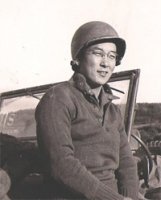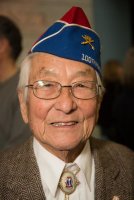nhboy
Ubi bene ibi patria
Link
"Much has been written about the brutal Lost Battalion mission in France during World War II in which Japanese American soldiers of the 442nd Regimental Combat Team rescued a group of other U.S. soldiers cut off by the German enemy.
The tales of loss and ultimate victory in the multi-day battle are harrowing, but perhaps some of the most emotional documentations of the mission are photographs taken by Stockton-born soldier Susumu Ito, who carried a small camera during his time with the highly decorated 442nd.
One photo in particular drew attention during an exhibit of Ito's work this year at the Japanese American National Museum in Los Angeles. It showed a fellow soldier sitting down in a dense forest during a break in the action, his face buried in his hands.
"You don't know what he is thinking, what he's been through," said Lily Anne Welty Tamai, curator of history at the museum. "But people would stand in front of the Lost Battalion photos and cry."
Ito, who became a professor and researcher after the war at Harvard Medical School, died of natural causes at his home in Wellesley, Mass. He was 96.
Because he lived alone, his exact date of death was not known. Officials listed it as Sept. 29, said his son-in-law, James Ito-Adler.
Ito donated thousands of his pictures — including those of a Japanese American internment camp in the U.S. and of a liberated Nazi concentration camp near Dachau — to the museum's collection.
He was drafted into the Army in 1940 and probably could have avoided combat — trained as a mechanic, he was initially assigned to a heavy vehicle maintenance unit at Camp Haan in Riverside. After the attack on Pearl Harbor in 1941, he was "transferred into a boring, noncombatant station complement group" in Oklahoma with many other Japanese American soldiers, he said in an interview for the 2003 book about the 442nd, "And Then There Were Eight."
"They took our rifles away," he said in a 2011 interview with CNN. "They didn't know what to do with us." But Ito wanted to see action and volunteered to be in the artillery of a 442nd unit.
Meanwhile, his parents were among the more than 110,000 civilians of Japanese ancestry sent to internment camps during the war. While in Army training in Mississippi, Ito had the chance to visit them at the Rohwer Relocation Center in Arkansas (the same camp where actor George Takai spent part of his boyhood). With his inexpensive, 35-millimeter Agfa Memo camera, Ito took pictures of life in the barracks-like facilities.".....


More here.
"Much has been written about the brutal Lost Battalion mission in France during World War II in which Japanese American soldiers of the 442nd Regimental Combat Team rescued a group of other U.S. soldiers cut off by the German enemy.
The tales of loss and ultimate victory in the multi-day battle are harrowing, but perhaps some of the most emotional documentations of the mission are photographs taken by Stockton-born soldier Susumu Ito, who carried a small camera during his time with the highly decorated 442nd.
One photo in particular drew attention during an exhibit of Ito's work this year at the Japanese American National Museum in Los Angeles. It showed a fellow soldier sitting down in a dense forest during a break in the action, his face buried in his hands.
"You don't know what he is thinking, what he's been through," said Lily Anne Welty Tamai, curator of history at the museum. "But people would stand in front of the Lost Battalion photos and cry."
Ito, who became a professor and researcher after the war at Harvard Medical School, died of natural causes at his home in Wellesley, Mass. He was 96.
Because he lived alone, his exact date of death was not known. Officials listed it as Sept. 29, said his son-in-law, James Ito-Adler.
Ito donated thousands of his pictures — including those of a Japanese American internment camp in the U.S. and of a liberated Nazi concentration camp near Dachau — to the museum's collection.
He was drafted into the Army in 1940 and probably could have avoided combat — trained as a mechanic, he was initially assigned to a heavy vehicle maintenance unit at Camp Haan in Riverside. After the attack on Pearl Harbor in 1941, he was "transferred into a boring, noncombatant station complement group" in Oklahoma with many other Japanese American soldiers, he said in an interview for the 2003 book about the 442nd, "And Then There Were Eight."
"They took our rifles away," he said in a 2011 interview with CNN. "They didn't know what to do with us." But Ito wanted to see action and volunteered to be in the artillery of a 442nd unit.
Meanwhile, his parents were among the more than 110,000 civilians of Japanese ancestry sent to internment camps during the war. While in Army training in Mississippi, Ito had the chance to visit them at the Rohwer Relocation Center in Arkansas (the same camp where actor George Takai spent part of his boyhood). With his inexpensive, 35-millimeter Agfa Memo camera, Ito took pictures of life in the barracks-like facilities.".....


More here.
